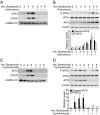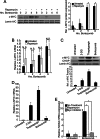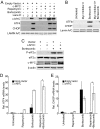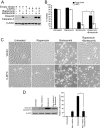Mammalian target of rapamycin complex 1 (mTORC1) enhances bortezomib-induced death in tuberous sclerosis complex (TSC)-null cells by a c-MYC-dependent induction of the unfolded protein response
- PMID: 23612979
- PMCID: PMC3668728
- DOI: 10.1074/jbc.M112.431056
Mammalian target of rapamycin complex 1 (mTORC1) enhances bortezomib-induced death in tuberous sclerosis complex (TSC)-null cells by a c-MYC-dependent induction of the unfolded protein response
Abstract
Many factors, including duration and intensity of the unfolded protein response (UPR), dictate whether cells will adapt to endoplasmic reticulum stress or undergo apoptosis. In tuberous sclerosis (TSC), elevation of mammalian target of rapamycin complex 1 (mTORC1) activity has been proposed to compound the induction of UPR transcription factors ATF4 and CHOP, suggesting that the UPR could be targeted to eradicate TSC1/2-null cells during patient therapy. Here we report that control of c-MYC translation by mTORC1 plays a key role in determining whether TSC2-null Elt3 rat leiomyoma cells apoptose in response to UPR induction by the proteasome inhibitor bortezomib. Although bortezomib induces eukaryotic initiating factor 2α phosphorylation, mTORC1 activity was also required for downstream induction of the UPR transcription factors ATF4 and CHOP by a mechanism involving increased expression of c-MYC. Although bortezomib-induced c-MYC transcription was resistant to rapamycin treatment, mTORC1 activity was required for efficient c-MYC translation. c-MYC subsequently bound to the ATF4 promoter, suggesting direct involvement of an mTORC1/c-MYC-driven signaling pathway in the activation of the UPR. Consistent with this notion, exogenously expressed c-MYC reversed the ability of rapamycin to prevent bortezomib-induced CHOP and ATF4 expression as well as apoptosis. These findings indicate that the induction of ATF4/CHOP expression occurs via mTORC1 regulation of c-MYC and that this signaling pathway is a major determinant in the ability of bortezomib to induce apoptosis.
Keywords: ATF4; Apoptosis; Bortezomib; Myc; Rapamycin; Tuberous Sclerosis (Tsc); Unfolded Protein Response; mTOR.
Figures








Similar articles
-
The TSC1 and TSC2 tumor suppressors are required for proper ER stress response and protect cells from ER stress-induced apoptosis.Cell Death Differ. 2011 Jan;18(1):133-44. doi: 10.1038/cdd.2010.82. Epub 2010 Jul 9. Cell Death Differ. 2011. PMID: 20616807 Free PMC article.
-
Human TSC-associated renal angiomyolipoma cells are hypersensitive to ER stress.Am J Physiol Renal Physiol. 2012 Sep 15;303(6):F831-44. doi: 10.1152/ajprenal.00441.2011. Epub 2012 Jul 11. Am J Physiol Renal Physiol. 2012. PMID: 22791333 Free PMC article.
-
Activation of ATF4 mediates unwanted Mcl-1 accumulation by proteasome inhibition.Blood. 2012 Jan 19;119(3):826-37. doi: 10.1182/blood-2011-07-366492. Epub 2011 Nov 29. Blood. 2012. PMID: 22128141
-
Mammalian target of rapamycin and tuberous sclerosis complex.J Dermatol Sci. 2015 Aug;79(2):93-100. doi: 10.1016/j.jdermsci.2015.04.005. Epub 2015 Apr 25. J Dermatol Sci. 2015. PMID: 26051878 Review.
-
Mourning Dr. Alfred G. Knudson: the two-hit hypothesis, tumor suppressor genes, and the tuberous sclerosis complex.Cancer Sci. 2017 Jan;108(1):5-11. doi: 10.1111/cas.13116. Epub 2017 Jan 23. Cancer Sci. 2017. PMID: 27862655 Free PMC article. Review.
Cited by
-
Oncogenic effects of urotensin-II in cells lacking tuberous sclerosis complex-2.Oncotarget. 2016 Sep 20;7(38):61152-61165. doi: 10.18632/oncotarget.10748. Oncotarget. 2016. PMID: 27458154 Free PMC article.
-
Target of Rapamycin Complex 2 regulates cell growth via Myc in Drosophila.Sci Rep. 2015 May 22;5:10339. doi: 10.1038/srep10339. Sci Rep. 2015. PMID: 25999153 Free PMC article.
-
Endoplasmic reticulum stress-induced apoptosis in intestinal epithelial cells: a feed-back regulation by mechanistic target of rapamycin complex 1 (mTORC1).J Anim Sci Biotechnol. 2018 May 3;9:38. doi: 10.1186/s40104-018-0253-1. eCollection 2018. J Anim Sci Biotechnol. 2018. PMID: 29744053 Free PMC article.
-
Together JUN and DDIT3 (CHOP) control retinal ganglion cell death after axonal injury.Mol Neurodegener. 2017 Oct 2;12(1):71. doi: 10.1186/s13024-017-0214-8. Mol Neurodegener. 2017. PMID: 28969695 Free PMC article.
-
mTOR-Mediated Regulation of Immune Responses in Cancer and Tumor Microenvironment.Front Immunol. 2022 Feb 18;12:774103. doi: 10.3389/fimmu.2021.774103. eCollection 2021. Front Immunol. 2022. PMID: 35250965 Free PMC article. Review.
References
-
- Crino P. B., Nathanson K. L., Henske E. P. (2006) The tuberous sclerosis complex. New Eng. J. Med. 355, 1345–1356 - PubMed
-
- Castro A. F., Rebhun J. F., Clark G. J., Quilliam L. A. (2003) Rheb binds tuberous sclerosis complex 2 (TSC2) and promotes S6 kinase activation in a rapamycin- and farnesylation-dependent manner. J. Biol. Chem. 278, 32493–32496 - PubMed
-
- Zhang Y., Gao X., Saucedo L. J., Ru B., Edgar B. A., Pan D. (2003) Rheb is a direct target of the tuberous sclerosis tumour suppressor proteins. Nat. Cell Biol. 5, 578–581 - PubMed
Publication types
MeSH terms
Substances
Grants and funding
LinkOut - more resources
Full Text Sources
Other Literature Sources
Research Materials
Miscellaneous

